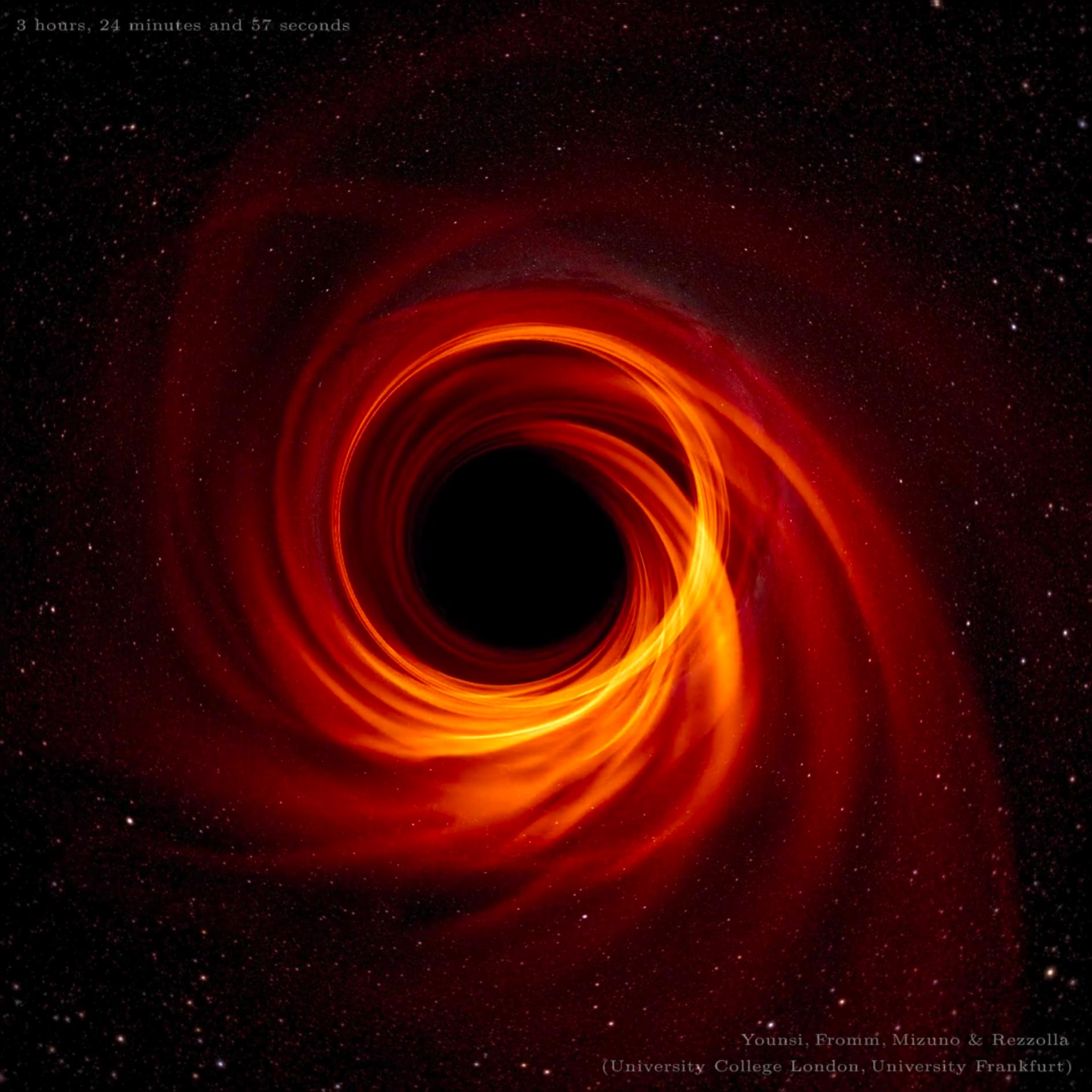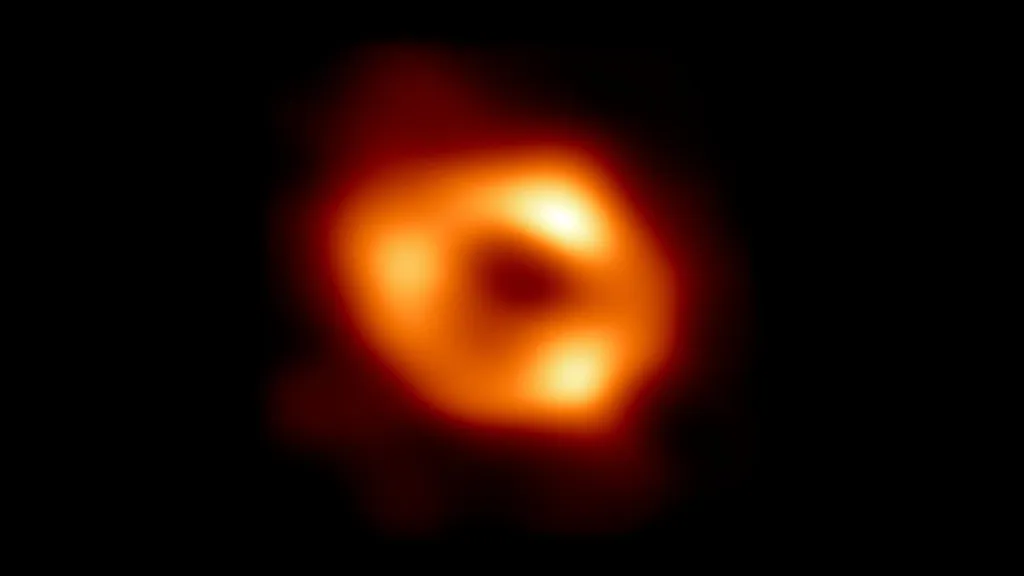

This is the first image of Sagittarius A* (Sgr A*), the supermassive black hole at the center of our galaxy, captured by the Event Horizon Telescope (EHT). It is the first direct visual evidence of the presence of this black hole. Credit: EHT Collaboration
Astronomers reveal the first image of the black hole at the heart of our galaxy. It is the first direct visual evidence of a ring-like structure like M87*. Theoretical Physicists of Goethe University Frankfurt were instrumental in interpreting the data.
Astronomers have unveiled the first image of the supermassive black hole at the center of our own Milky Way galaxy. This result provides overwhelming evidence that the object is indeed a black hole and yields valuable clues about the workings of such giants, which are thought to reside at the center of most galaxies. The image was produced by a global research team called the Event Horizon Telescope (EHT) Collaboration, using observations from a worldwide network of radio telescopes. Theoretical Physicists from Goethe University Frankfurt were instrumental in interpreting the data.
The image is a long-anticipated look at the massive object that sits at the very center of our galaxy. Scientists had previously seen stars orbiting around something invisible, compact, and very massive at the center of the Milky Way. This strongly suggested that this object — known as Sagittarius A* (Sgr A*, pronounced “sadge-ay-star”) — is a black hole, and this new image provides the first direct visual evidence of it.

Example of a simulation of how the gas orbits the black hole in the center of our Milky Way and emits radio waves at 1.3 mm. Credit: Younsi, Fromm, Mizuno & Rezzolla (University College London, Goethe University Frankfurt
Although we cannot see the black hole itself, because it is completely dark, glowing gas around it reveals a tell-tale signature: a dark central region (called a “shadow”) surrounded by a bright ring-like structure. The new view captures light bent by the powerful gravity of the black hole, which is four million times more massive than our Sun.
“We were stunned by how well the size of the ring agreed with predictions from Einstein’s theory of general relativity,” says EHT Project Scientist Geoffrey Bower from the Institute of Astronomy and Astrophysics, Academia Sinica, Taipei. “These unprecedented observations have greatly improved our understanding of what happens at the very center of our galaxy and offer new insights on how these giant black holes interact with their surroundings.”
What does it take to capture an image of the black hole at the center of our galaxy? This video explains how the Event Horizon Telescope (EHT) works, and how astronomers managed to create one massive Earth-sized telescope big enough to “see” at the edge of black holes. Credit: ESO
Because the black hole is about 27,000 light-years away from Earth, it appears to us to have about the same size in the sky as a donut on the Moon. To image it, the team created the powerful EHT, which linked together eight existing radio observatories across the planet to form a single “Earth-sized” virtual telescope. The EHT observed Sgr A* on multiple nights, collecting data for many hours in a row, similar to using a long exposure time on a camera.
The enormous amount of observational data collected had to be interpreted theoretically. For this, a research team led by theoretical astrophysicist Luciano Rezzolla from Goethe University Frankfurt used supercomputers to simulate how a black hole could look like when observed by the EHT – based on what had already been known about Sgr A*. In this way, the scientists created a library of millions of images. Then, they compared this image library with the thousands of different images of the EHT to deduce the properties of Sgr A*.
The breakthrough follows the EHT Collaboration’s 2019 release of the first image of a black hole, called M87*, at the center of the more distant Messier 87 galaxy.

Luciano Rezzolla, Professor für Theoretische Astrophysik, Goethe-Universität Frankfurt. Credit: Juergen Lecher
The two black holes look remarkably similar, even though our galaxy’s black hole is more than a thousand times smaller and less massive than M87*. “We have two completely different types of galaxies and two very different black hole masses, but close to the edge of these black holes they look amazingly similar,” says Sera Markoff, Vice Chair of the EHT Science Council and a professor of theoretical astrophysics at the University of Amsterdam, the Netherlands. “This tells us that general relativity governs these objects up close, and any differences we see further away must be due to differences in the material that surrounds the black holes.”
This achievement was considerably more difficult than for M87*, even though Sgr A* is much closer to us. EHT scientist Chi-kwan (‘CK’) Chan, from Steward Observatory, the Department of Astronomy and the Data Science Institute at the University of Arizona, US, explains: “The gas in the vicinity of the black holes moves at the same speed — nearly as fast as light — around both Sgr A* and M87*. But where gas takes days to weeks to orbit the larger M87*, in the much smaller Sgr A* it completes an orbit in mere minutes. This means the brightness and pattern of the gas around Sgr A* was changing rapidly as the EHT Collaboration was observing it — a bit like trying to take a clear picture of a puppy quickly chasing its tail.”
The researchers had to develop sophisticated new tools that accounted for the gas movement around Sgr A*. While M87* was an easier, steadier target, with nearly all images looking the same, that was not the case for Sgr A*. The image of the Sgr A* black hole is an average of the different images the team extracted, finally revealing the giant lurking at the center of our galaxy for the first time.
The effort was made possible through the ingenuity of more than 300 researchers from 80 institutes around the world that together make up the EHT Collaboration. In addition to developing complex tools to overcome the challenges of imaging Sgr A*, the team worked rigorously for five years, using supercomputers to combine and analyze their data, all while compiling an unprecedented library of simulated black holes to compare with the observations.
Luciano Rezzolla, professor of Theoretical Astrophysics at Goethe University Frankfurt, explains: “The mass and distance of the object were known very precisely before our observations. We thus used these tight constraints on the size of the shadow to rule out other compact objects – such as boson stars or wormholes – and conclude that: ‘What we’re seeing definitely looks like a black hole!’”
Using advanced numerical codes, theorists in Frankfurt have performed extensive calculations on the properties of the plasma accreting onto the black hole. Rezzolla: “We managed to calculate three million synthetic images varying the accretion and radiation emission models, and considering the variations seen by observers at different inclinations with respect to the black hole.”
This last operation was necessary because the image of a black hole can be radically different when seen by observers at different inclinations. “Indeed, a reason why our images of Sgr A* and M87* are rather similar is because we’re seeing the two black holes from an almost identical angle,” Rezzolla explains.
“To understand how the EHT has produced an image of Sgr A* one can think of producing a picture of a mountain peak based on a time-lapse video. While most of the time the peak will be visible in the time-lapse video, there are times when it is not because it is obscured by clouds. On average, however, the peak is clearly there. Something similar is true also for Sgr A*, whose observations lead to thousands of images that have been collected in four classes and then averaged according to their properties. The end result is a clear first image of the black hole at the center of the Milky Way.” Rezzolla concludes.
Scientists are particularly excited to finally have images of two black holes of very different sizes, which offers the opportunity to understand how they compare and contrast. They have also begun to use the new data to test theories and models of how gas behaves around supermassive black holes. This process is not yet fully understood but is thought to play a key role in shaping the formation and evolution of galaxies.
“Now we can study the differences between these two supermassive black holes to gain valuable new clues about how this important process works,” says EHT scientist Keiichi Asada from the Institute of Astronomy and Astrophysics, Academia Sinica, Taipei. “We have images for two black holes — one at the large end and one at the small end of supermassive black holes in the Universe — so we can go a lot further in testing how gravity behaves in these extreme environments than ever before.”
Progress on the EHT continues: a major observation campaign in March 2022 included more telescopes than ever before. The ongoing expansion of the EHT network and significant technological upgrades will allow scientists to share even more impressive images as well as videos of black holes in the near future.
Reference: “First Sagittarius A* Event Horizon Telescope Results. I. The Shadow of the Supermassive Black Hole in the Center of the Milky Way” by Kazunori Akiyama, Antxon Alberdi, Walter Alef, Juan Carlos Algaba, Richard Anantua, Keiichi Asada, Rebecca Azulay, Uwe Bach, Anne-Kathrin Baczko, David Ball, Mislav Balokovic, John Barrett, Michi Bauböck, Bradford A. Benson, Dan Bintley, Lindy Blackburn, Raymond Blundell, Katherine L. Bouman, Geoffrey C. Bower, Hope Boyce, Michael Bremer, Christiaan D. Brinkerink, Roger Brissenden, Silke Britzen, Avery E. Broderick, Dominique Broguiere, Thomas Bronzwaer, Sandra Bustamante, Do-Young Byun, John E. Carlstrom, Chiara Ceccobello, Andrew Chael, Chi-kwan Chan, Koushik Chatterjee, Shami Chatterjee, Ming-Tang Chen, Yongjun Chen, Xiaopeng Cheng, Ilje Cho, Pierre Christian, Nicholas S. Conroy, John E. Conway, James M. Cordes, Thomas M. Crawford, Geoffrey B. Crew, Alejandro Cruz-Osorio, Yuzhu Cui, Jordy Davelaar, Mariafelicia De Laurentis, Roger Deane, Jessica Dempsey, Gregory Desvignes, Jason Dexter, Vedant Dhruv, Sheperd S. Doeleman, Sean Dougal, Sergio A. Dzib, Ralph P. Eatough, Razieh Emami, Heino Falcke, Joseph Farah, Vincent L. Fish, Ed Fomalont, H. Alyson Ford, Raquel Fraga-Encinas, William T. Freeman, Per Friberg, Christian M. Fromm, Antonio Fuentes, Peter Galison, Charles F. Gammie, Roberto García, Olivier Gentaz, Boris Georgiev, Ciriaco Goddi, Roman Gold, Arturo I. Gómez-Ruiz, José L. Gómez, Minfeng Gu, Mark Gurwell, Kazuhiro Hada, Daryl Haggard, Kari Haworth, Michael H. Hecht, Ronald Hesper, Dirk Heumann, Luis C. Ho, Paul Ho, Mareki Honma, Chih-Wei L. Huang, Lei Huang, David H. Hughes, Shiro Ikeda, C. M. Violette Impellizzeri, Makoto Inoue, Sara Issaoun, David J. James, Buell T. Jannuzi, Michael Janssen, Britton Jeter, Wu Jiang, Alejandra Jiménez-Rosales, Michael D. Johnson, Svetlana Jorstad, Abhishek V. Joshi, Taehyun Jung, Mansour Karami, Ramesh Karuppusamy, Tomohisa Kawashima, Garrett K. Keating, Mark Kettenis, … John Test, Karl Torstensson, Paulina Venegas, Craig Walther, Ta-Shun Wei, Chris White, Gundolf Wieching, Rudy Wijnands, Jan G. A. Wouterloot, Chen-Yu Yu, Wei Yu and Milagros Zeballos, 12 May 2022, The Astrophysical Journal Letters.
DOI: 10.3847/2041-8213/ac6674
A number of scientists from Goethe University are associated with the EHT Collaboration. Together with Professor Luciano Rezzolla, Dr. Alejandro Cruz Orsorio, Dr. Prashant Kocherlakota and Kotaro Moriyama, also Prof Mariafelicia De Laurentis (University of Naples), Dr. Christian Fromm (University of Würzburg), Prof Roman Gold (University of Southern Denmark), Dr. Antonios Nathanail (University of Athens), and Dr. Ziri Younsi (University College London) have provided essential contributions to the theoretical research in the EHT Collaboration.
This work has been supported by the European Research Council.

